Zotac GeForce GT 640 DDR3 Review: Glacial Gaming & Heavenly HTPC
by Ryan Smith & Ganesh T S on June 20, 2012 12:00 PM ESTPower, Temperature, & Noise
As always, we wrap up our look at a new video card with a look at the physical performance attributes: power consumption, temperatures, and noise. NVIDIA is breaking new ground for desktop Kepler with their first sub-75W card, so it will be interesting to see just what the tradeoff is for such low power consumption.
| Zotac GeForce GT 640 DDR3 Voltages | |||
| GT 640 Idle | GT 640 Load | ||
| 0.95v | 1.00v | ||
NVIDIA doesn’t do a lot of voltage scaling with the GT 640. At idle it runs at 0.95v, and makes a short jump to 1.00v under full load. For a 28nm GPU 0.95v under idle is a bit higher than what we’ve seen in the past, which may explain the official 15W idle TDP.
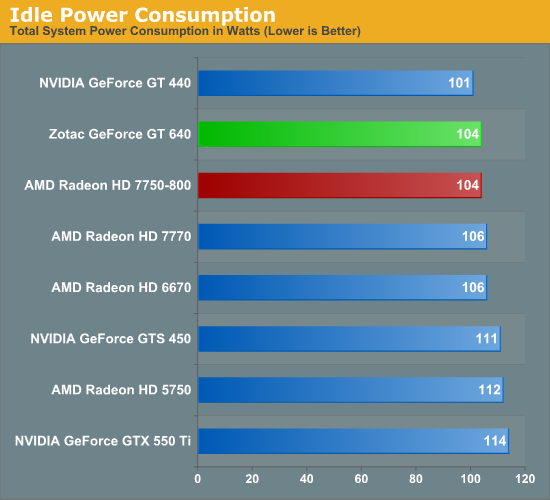
Earlier we theorized that the GT 640 would have worse idle power characteristics than the GT 440, and this appears to be the case. The difference at the wall is all of 3W but it’s a solid indication that NVIDIA has at best not improved on their idle power consumption, if not made it a bit worse. The good news for them is that in spite of this slight rise in idle power consumption it’s still enough to tie the 7750 and beat older cards like the 6670 and GTS 450.
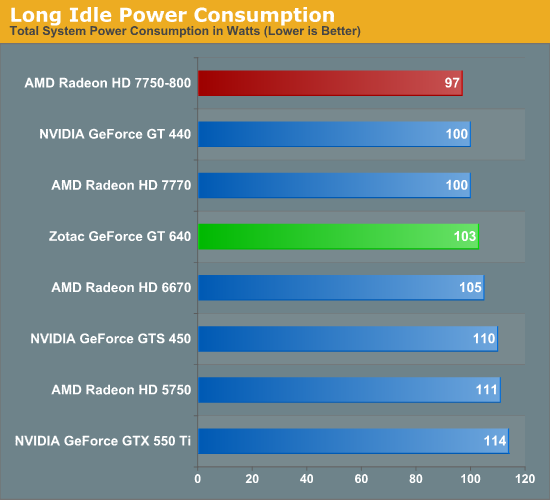
Long idle on the other hand sees the 7750 jump back into the lead, as NVIDIA doesn’t have anything resembling AMD’s ZeroCore power technology.
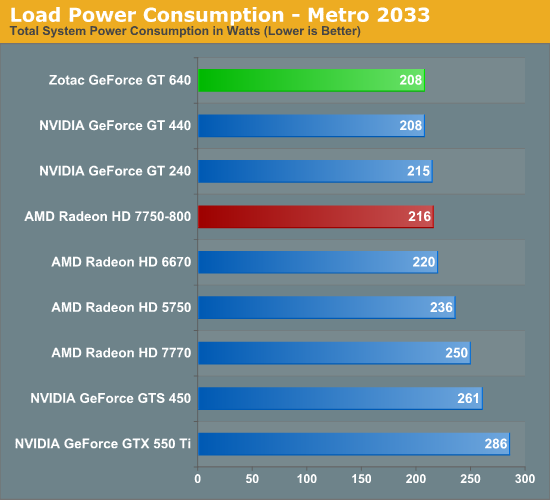
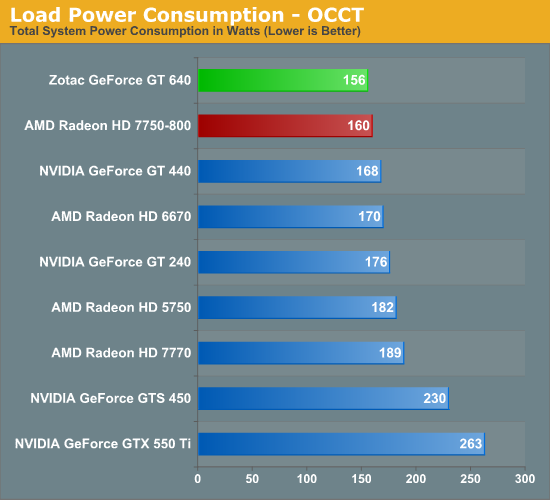
Of all of the sub-75W cards in our benchmark suite, the GT 640 ends up having the lowest load power consumption. Under both Metro and OCCT it’s equal to or better than the GT 440, GT 240, 6670, and 7750. AMD’s official PowerTune limit on the latter is 75W versus the GT 640’s 65W TDP, so this is not unexpected, but it’s always nice to have it confirmed in numbers. That said, for desktop usage I’m not sure 4-8W at the wall is all that big of a deal. So while NVIDIA’s power consumption is marginally lower than the 7750 they aren’t necessarily gaining anything tangible from it, particularly when you consider the loss in performance.

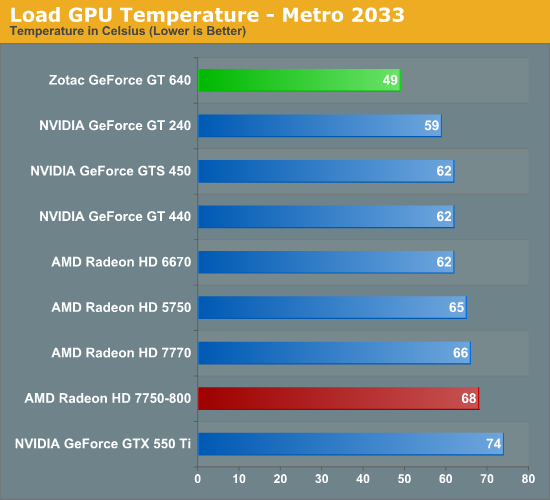
GPU temperatures look absolutely stunning here, and in fact it’s better than we would have expected. Zotac’s heatsink is not particularly large, and while these type of cards typically stay under 70C we would not have expected a single-slot heatsink to perform this well. If these kinds of temperatures can carry over into other designs there’s a very good chance we’re going to see some nice passively cooled cards in the near future. In the meantime buyers sheepish about high temperatures are going to find that Zotac’s GT 640 is an exceptional card.
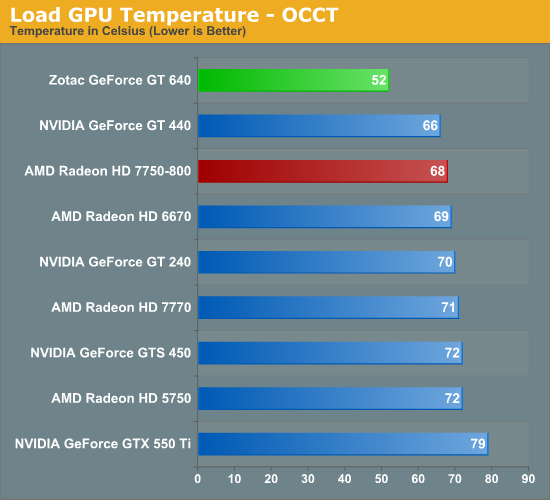

Last but not least we have noise. Zotac’s card may be exceptionally cool, but that single slot cooler and small fan comes back to bite them when it comes to noise. That little fan simply doesn’t idle well, leading to the Zotac GT 640 being one of the loudest idling sub-75W card we’ve seen in quite some time. Zotac fares much better under load – where the 7750’s equally tiny and tinny fan leads to the 7750 ending up as the louder card by about 1dB – but really neither of these cards is particularly quiet for as little power as they consume. HTPC users who aren’t already looking at passively cooled cards are probably going to want to look elsewhere unless they absolutely need a single-slot card, as there’s a very clear tradeoff on size versus noise here.










60 Comments
View All Comments
HighTech4US - Wednesday, June 20, 2012 - link
At least hen the GT240 was released it came in both DDR3 and GDDR5.UNhooked - Wednesday, June 20, 2012 - link
I wish there was some sort of Video encoding benchmark. I have been told AMD/ATI cards aren't very good when it comes to video encoding.mosu - Thursday, June 21, 2012 - link
who told you that kind of crap ?Please check the internet.Rumpelstiltstein - Thursday, June 21, 2012 - link
Did this low-end offering really manage to pull off these kind of numbers? I'm impressed. Not something I would buy personally, but I would have no problems recommending this to someone else.Samus - Thursday, June 21, 2012 - link
DDR3....ruined a perfectly good chip.Deanjo - Thursday, June 21, 2012 - link
Noooooo! Come on, post some benchmarks as it is right now. Some of us do not want to wait for AMD to get their VCE in order. People have been waiting for VCE for months and there is no valid reason to hold off NVENC waiting for their competitor to catch up. When and if VCE support comes out then run a comparison then.
ganeshts - Thursday, June 21, 2012 - link
NVIDIA indicated that official NVENC support in CyberLink / ArcSoft transcoding applications would come in July only. Till then, it is beta, and has scope for bugs.Deanjo - Thursday, June 21, 2012 - link
So? That didn't prevent them benching trinity and it's encoding capabilities despite it all being beta there.http://www.anandtech.com/show/5835/testing-opencl-...
drizzo4shizzo - Thursday, June 21, 2012 - link
So... do these new cards still support HDTV 1080i analog signals for those of us who refuse to give up our 150lb 34" HDTV CRTs?ie. ship with a breakout dongle cable that plugs into the DVI-I port? If they don't ship with one can anyone tell me if they are compatible with a 3rd party solution? For it to work the card has to convert to the YUV colorspace. My old 7600gt *did* support this feature, but none of the new cards mention it...
Upgrading my TV also means buying a new receiver for HDMI switching to the projector, fishing cable in walls, and all manner of other unacceptable tradeoffs. Plus monay.
Thanks!
philipma1957 - Thursday, June 21, 2012 - link
I have a sapphire hd7750 ultimate passive cooled card.This card seems to be worse in every case except it is 1 slot not 2.
The passive hd7750 is 125 usd this is 110 usd.
I am not sure that I would want this until they make a passive version.